I arrived at my sit spot at dusk, 6:15pm on Monday, October 26, 2020. I wanted to visit while it was raining, but I missed my opportunity. Maybe next time I will catch it at the right moment. I usually come to my sit spot late day/dusk because I believe that is when I will see the most wildlife. So far, I have been quite lucky to see all that I have, but I hope to see much more. The creatures that I would really like to see such as deer, coyotes, and skunks seem to be more active closer to nighttime, but I don’t enjoy the thought of stumbling along the Creekside in the dark, so dusk is the best option for me. I would very much like to see what is active at my sit spot other times of the day, so I am excited about my next session.
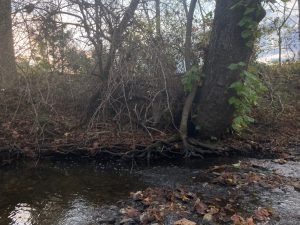 As I walked to my sit spot, a huge flock of birds flew overhead, filling the sky with their song. I then trekked through the line of forest and sat down on the Creekside to begin my observation. I noticed that the foliage along the forest floor had begun to thin out and a thick layer of freshly fallen leaves covered the ground. The trees are much bearer than they were during my last visit and I could see farther into the woods. The water level was much higher due to the recent rainfall. Thankfully, the bank where I sit was still dry. The weather was a comfortable 66 degrees Fahrenheit, a light breeze just strong enough to circulate the air. The sky began as a bright baby blue with scattered clouds beginning to turn a soft orange due to the sunset. As time passed, the sky overhead darkened to a deep periwinkle and the horizon a light peach. The clouds dissipated, only several low-floating grey ones lingered along the horizon.
As I walked to my sit spot, a huge flock of birds flew overhead, filling the sky with their song. I then trekked through the line of forest and sat down on the Creekside to begin my observation. I noticed that the foliage along the forest floor had begun to thin out and a thick layer of freshly fallen leaves covered the ground. The trees are much bearer than they were during my last visit and I could see farther into the woods. The water level was much higher due to the recent rainfall. Thankfully, the bank where I sit was still dry. The weather was a comfortable 66 degrees Fahrenheit, a light breeze just strong enough to circulate the air. The sky began as a bright baby blue with scattered clouds beginning to turn a soft orange due to the sunset. As time passed, the sky overhead darkened to a deep periwinkle and the horizon a light peach. The clouds dissipated, only several low-floating grey ones lingered along the horizon.
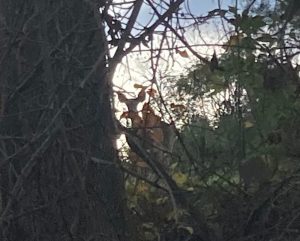 During this session, I finally spotted a deer. It was located on the opposite bank from me and appeared to be a doe, but it did not stick around very long. It took notice of me but did not seem to mind my presence. It leisurely made its way along the bank, disappearing over the hill. One thing that I noticed was the song of cicadas was no longer present. Only the chirp of crickets could be heard as the weather started to cool. I could hear the scurry of squirrels as they ran across tree branches above me, sending twigs crashing to the ground, but I never saw any. On the fallen ash tree to my left, I heard the call of a blue jay. I looked over just in time to watch it fly overhead and land in a tree further upstream. I wish I could have observed it longer so I could figure out what it was doing.
During this session, I finally spotted a deer. It was located on the opposite bank from me and appeared to be a doe, but it did not stick around very long. It took notice of me but did not seem to mind my presence. It leisurely made its way along the bank, disappearing over the hill. One thing that I noticed was the song of cicadas was no longer present. Only the chirp of crickets could be heard as the weather started to cool. I could hear the scurry of squirrels as they ran across tree branches above me, sending twigs crashing to the ground, but I never saw any. On the fallen ash tree to my left, I heard the call of a blue jay. I looked over just in time to watch it fly overhead and land in a tree further upstream. I wish I could have observed it longer so I could figure out what it was doing.
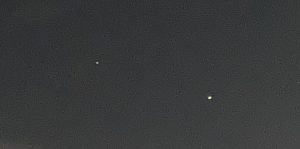
As winter continues to approach, the days remain shorter and shorter. The sun began to set much faster than it did during my other sit spot sessions. Within 30 minutes of observation, it was already dark enough that a flashlight could be used, but light enough that it was not necessary. I enjoy this time of day because this is when the stars begin to show up. I took notice of how bright the moon was, currently a waning gibbous. I also spotted 3 different planets: Mars, Jupiter, and Saturn. I enjoy stargazing, so I found this to be very cool. Saturn and Jupiter are pictured to the left respectively, and Mars is pictured to the right.
Before it was too dark outside, I check on my 3 things. First, I examined the creek. The water level was higher due to the recent rain and the channels connecting the upper part of the creek to the lower were wider than they were before. There was also much more leaf litter and sediment, which I assumed would be the case due to the shedding of leaves from the trees. Next, I checked on the great sycamore. It still stood lush and tall, but its leaves were beginning to turn a yellow color rather than the deep green they were earlier in the year. I expect it will not be long now before its branches are bare. Finally, I studied the burrows within the tree roots. Not much seemed to have changed, however, I hope the fresh leaf litter will indicate if the burrows are still used or not. I will continue to monitor and watch for trails or trampled leaves leading up to the burrow.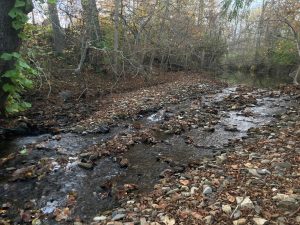
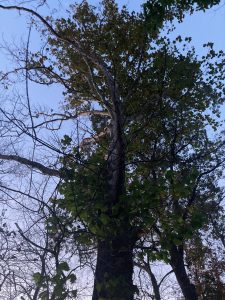
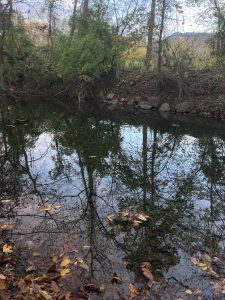
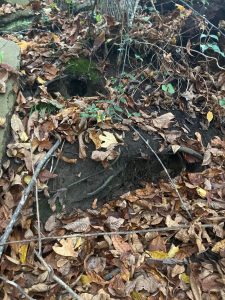

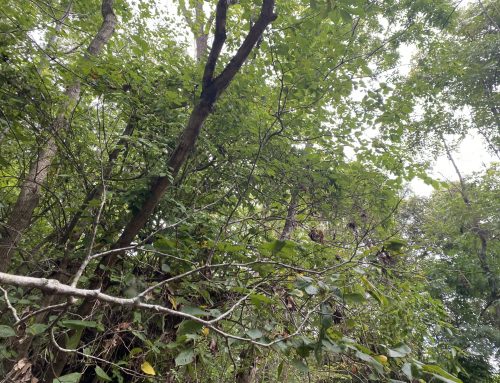
Leave A Comment
You must be logged in to post a comment.